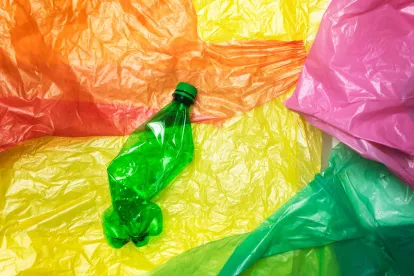The war on plastics and petrochemicals has ramped up in 2023. The first two months of the year have seen the petrochemical supply chain under stress.
In this update, we will discuss how various actions, including (i) a train derailment in East Palestine, Ohio, (ii) NGO-led pressure campaigns, and (iii) difficulties recycling plastic products are challenging the sector. Finally, we will discuss how these independent events relate to ongoing policy dialogues related to sustainability, environmental justice, and ESG.
i. East Palestine Train Derailment
In early February, a Norfolk Southern train derailed, releasing various hazardous materials to the air, surface soils, and surface water in East Palestine, Ohio.
The derailment caused several rail cars—including some carrying hazardous substances—to catch fire, burning for several days. Five tanker cars containing vinyl chloride (VC)—a flammable gas used to make polyvinyl chloride pipes, vehicle upholstery, wire coatings, and plastic kitchenware—were emptied into a trench for a controlled burn to prevent the VC from exploding. Ohio and Pennsylvania ordered residents living near the derailment to evacuate from their homes temporarily.
Many residents—fueled by mistrust and fearing long-term effects—have sought independent environmental testing even though federal and state regulators have already indicated that any hazardous chemicals released from the derailment do not pose a threat. Residents living near the derailment site have complained of symptoms including rashes, headaches, nausea, and bloody noses, and more than 43,000 fish and animals have been reportedly killed. Late last month, US EPA issued an order directing Norfolk Southern to clean up the site of the derailment.
Three takeaways:
-
Being prepared for industrial accidents, even in the absence of a regulatory requirement, is critical and can best position companies to avoid or mitigate potential liability.
-
Risk is not always clear. Communicating about risk and being prepared to respond to community concerns is a necessary part of emergency response.
-
Accidents often drive more stringent regulatory oversight and increase public critiques. Here, advocacy groups have used the presence of VC on the train to push to ban VC even though the derailment was unrelated to the train’s cargo.
ii. EPA Files Clean Air Act Suit Against Louisiana Plastic Facility
We move next to Louisiana where EPA recently filed a complaint under Section 303 of the Clean Air Act (CAA) to compel a facility operator – Denka Performance Elastomer (Denka) – to significantly reduce chloroprene emissions from its neoprene manufacturing facility. EPA’s complaint asserts that the facility’s chloroprene emission causes an imminent and substantial endangerment to public health. More specifically, EPA alleges that children are particularly vulnerable to chloroprene and that “Denka’s chloroprene’s emissions reach more than 300 young children who attend the 5th Ward Elementary School, located within approximately 450 feet of Denka’s facility.”
Last year, we wrote about the Denka facility in the context of EPA’s civil rights petition against Louisiana regulators who permitted it. (See here.) At that time, EPA sought to require Louisiana regulators to conduct a more stringent analysis due to the proximity of the school to the fence line of a facility.
Federal regulators themselves suing Denka – the facility operator – is an escalation in EPA’s EJ activities as EPA is now pursuing an industrial operator and not just engaging with state regulators. (We pondered when this would happen here.) Additionally, EPA filed suit using tools referenced in a document released by EPA’s Office of General Counsel focused on legal tools to address “cumulative impacts.” (Find our prior discussion here.)
What to watch:
-
Louisiana has been a focus for public and private efforts in the EJ space. The Denka facility – and a second facility operated by Formosa Plastics – are sited in an area dubbed “Cancer Alley” by EJ advocates.
-
As with the train derailment, no company wants to be named as a defendant in an EPA enforcement suit. Here, EPA’s claims are not typical CAA claims for violations of CAA’s National Emission Standards for Hazardous Air Pollutants (NESHAP) regulations, 40 CFR Parts 61 and 63. Instead, EPA is pursuing more stringent remedies by relying in part on “fenceline data” and the proximity of a school with an industrial facility. (For a discussion on “fenceline data,” see here,)
iii. Recycling and Plastics
Two final developments highlight issues that plastic products can present to corporate sustainability.
Keurig Settlement. In Smith v. Keurig Green Mountain, a case we wrote about here and here, the Northern District of California recently approved a $10 million nationwide class action settlement to resolve allegations that Keurig Green Mountain, Inc. misleadingly labeled single-serve plastic coffee pods (“K-cups” or “Pods”) as “recyclable.”
Plaintiffs in Smith sued in 2018, alleging that some Pods were not recyclable because not all municipal recycling facilities accepted the Pods and there is a lack of end markets to recycle Pods. When it moved to dismiss the suit, Keurig asserted that the Pods’ labels were compliant with the FTC’s Green Guides because they contain proper qualifying statements like “Check locally* to recycle empty cup,” with the asterisk allegedly indicating that the Pods may not be “recycled in all communities.” The Court denied Keurig’s motion, finding that the complaint adequately alleged that the Pods’ size and design made them non-recyclable; which, if true, would make the company’s “recyclable” claims non-compliant with the Green Guides.
According to the settlement, individual consumers may receive between $5-$36, depending on whether the consumer has proof of purchase and how many pods they purchased. Keurig will also include the disclaimer, “Check Locally – Not Recycled in Many Communities” on affected products.
Smith is one among a wave of similar lawsuits including Curtis v. 7-Eleven., No. 1:21-cv-06079, ECF No. 1 (N.D. Ill. Nov. 12, 2021) (alleged misleading use of the term “recyclable” for disposable plasticware that not all recycling facilities accepted for recycling); Haggerty v. Bluetriton Brands, Inc., No. 3:21-cv-13904, ECF No. 1 (D.N.J. July 20, 2021) (alleged misleading use of the phrase “100% recyclable” on plastic water bottles where not all the products were recycled and the bottle caps and labels were allegedly not recyclable).
Controversy Surrounding Chevron Biofuels Facility. Another way to demonstrate “sustainability” is by finding new uses for materials which were historically discarded. One “new” use for discarded plastics involves using them as a feedstock for fuel products which are classified as “biofuels.” In January 2022, EPA announced a new effort under the Toxic Substances Control Act (TSCA) to streamline the review of new chemicals that could be used to displace “current, higher greenhouse gas emitting transportation fuels.” Through this effort, EPA sought to find “substitutes to petroleum-based fuels and fuel additives that use biobased or waste-derived sources to produce biofuels.” (Emphasis added.) EPA received 30 biofuel premanufacture notices (PMNs) that describe plans for close to 800 million gallons per year of advanced biofuels.
Among approved “biofuel” products were those tied to Chevron, which stresses striving for sustainability and lowering the overall carbon intensity of its operations. Chevron has sought to advance these goals in part through producing biofuels from plastic waste at a Pascagoula, Mississippi, Chevron refinery located in an EJ community. Because Chevron’s biofuel is relatively new, there is little publicly available data discussing what emissions from the biofuel processes would look like and press accounts link emissions from the biofuel process to a one-in-four lifetime cancer risk.
While this process remains evolving, the controversy itself shows that a company acting sustainably and finding a new use for discarded materials may still find itself with other challenges also relevant to ESG issues. Here, because it acted to reuse waste products to decrease carbon emissions, Chevron appears to have raised health concerns in a community where it operates.





 />i
/>i
